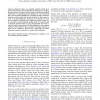Free Online Productivity Tools
i2Speak
i2Symbol
i2OCR
iTex2Img
iWeb2Print
iWeb2Shot
i2Type
iPdf2Split
iPdf2Merge
i2Bopomofo
i2Arabic
i2Style
i2Image
i2PDF
iLatex2Rtf
Sci2ools
TIT
2016
2016
Random Forests and Kernel Methods
—Random forests are ensemble methods which grow trees as base learners and combine their predictions by averaging. Random forests are known for their good practical performance, particularly in high-dimensional settings. On the theoretical side, several studies highlight the potentially fruitful connection between random forests and kernel methods. In this paper, we work out in full details this connection. In particular, we show that by slightly modifying their definition, random forests can be rewritten as kernel methods (called KeRF for Kernel based on Random Forests) which are more interpretable and easier to analyze. Explicit expressions of KeRF estimates for some specific random forest models are given, together with upper bounds on their rate of consistency. We also show empirically that KeRF estimates compare favourably to random forest estimates.
| Added | 11 Apr 2016 |
| Updated | 11 Apr 2016 |
| Type | Journal |
| Year | 2016 |
| Where | TIT |
| Authors | Erwan Scornet |
Comments (0)

